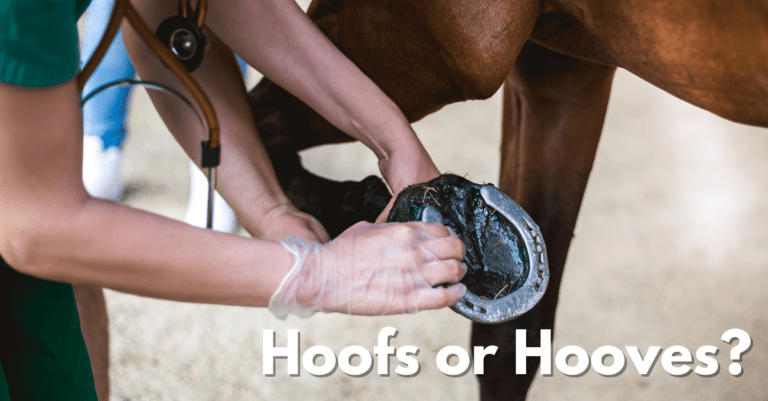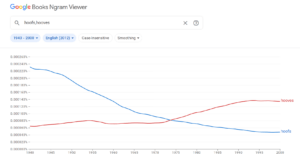Here’s a question for you: When you hear reindeer clattering on your roof, are you hearing their hoofs (H-O-O-F-S) or their hooves (H-O-O-V-E-S)?
Regular and Irregular Plurals
Nouns that take an S or ES to become plural are called regular nouns and nouns that become plural some other way are called irregular nouns. So hoofs is a regular plural and hooves is an irregular plural.
Drifting Toward Regularity
Usually, if a spelling changes, it’s in the direction of the word becoming regular. For example, the plural of the word brother used to be irregular (brethren), but now it’s usually regular (brothers). That’s the common way change happens: from irregular to regular. Language gets simpler over time.
But hoof is a rebel. It’s a rare example of a word that has gone the other way—from being regular to being irregular. Hoofs used to be more common, but now hooves is winning.
The Google Ngram is below, and a Reddit corpus search also shows that hooves is far more common.
Scarfs or Scarves?
Scarf is the same way: scarfs used to be more common, but now you’re more likely to see the plural spelled scarves, with that –ves plural again.
Two Acceptable Plurals
These are both cases where the word currently has two acceptable plurals. It’s weird; I know people like it better when I can say one is right and the other is wrong, but in both cases the spellings are correct. One is just more common than the other.
Dwarfs or Dwarves?
There’s another English word that has two plurals: dwarf. You can use either dwarfs or dwarves, but unlike hooves and scarves, dwarfs is still typically formed by adding S. So we can’t say there’s something special about nouns that end in F keeping their irregular plural because we’d have dwarfs to prove us wrong.
Dwarves in The Hobbit
Here’s a fun piece of trivia about dwarves. In the beginning of The Hobbit, the spelling of dwarves is one of two language points that J.R.R. Tolkien highlights:
“This is a story of long ago. At that time the languages and letters were quite different from ours today. English is used to represent the languages. But two points may be noted: (1) In English, the only correct plural of dwarf is dwarfs and the adjective is dwarfish. In this story, dwarves and dwarvish are used.” (The second point is about the word orc.)
Tolkien further explains in Lord of the Rings, Part III (Return of the King), that he chose the dwarves spelling to distance his dwarves of long ago from the sillier dwarfs of modern stories.
Use of the dwarves spelling has risen since Tolkien’s time, but it hasn’t overtaken dwarfs the way hooves and scarves overtook hoofs and scarfs.
So when you’re out looking for reindeer, wrap yourselves in warm scarves and listen for the sound of clattering hooves.
Image courtesy of Shutterstock.





